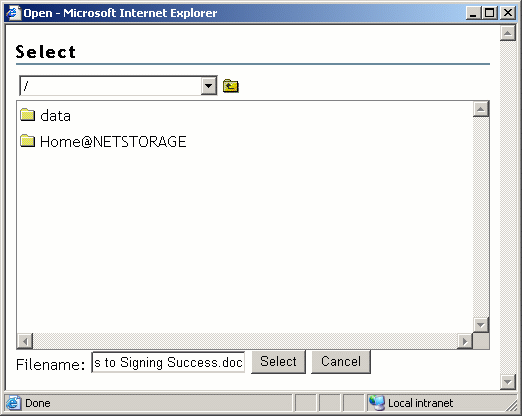5.2 Navigating the NetStorage Archive Interface
At the end of each scheduled epoch, the Novell Archive and Version Services captures a point-in-time copy of your eligible file structures and files. Over time, the archive database reflects the history of your network files and directories. You can access and restore file versions of current, renamed, and deleted files.
After you rename or delete your current files and directories, any related file versions remain in the archive database until affected by the archive’s delete policy. As you search for file versions, you can encounter multiple instances of sets of versions for any given filename or directory name. You must distinguish them based on your own knowledge of the history of a file.
To help you search the archive for a specific file version, the NetStorage access interface provides three levels of search dialogs:
5.2.1 Directory Contents Dialog Box
The Directory Contents dialog box lists a selected directory’s contents that exist in the archive database. Only files or directories to which you have rights appear in the list.
Directory entries can be directories, file version sets, and multiple version sets of a file or directory. If you have ever renamed or deleted a directory or file, then created another one with the same name, the archive distinguishes those instances and maintains sets of the related versions.
The Directory Contents dialog box conveys the following information:
-
Location: The directory path. For example: data/guest.
-
Name: The full name of the directory or file, including any file extensions. For example: myfile.txt.
-
Content List: A list of items found in the archived directory, including subdirectories, files, and version sets for a file.
-
Directory: A folder icon distinguishes the entry as a unique directory within the selected directory.
-
File: A page icon distinguishes the entry as a unique file within the selected directory.
-
Multiple Version Sets of a Directory or File : A question-mark (?) icon distinguishes the entry as a directory or file that has multiple version sets with the same name.
-
An Example Search of a Directory in the Archive Database
As an example, consider a situation in which a user wants to restore a previous version of a file “11 Steps to Signing Success.doc”. The user begins the search by locating and right-clicking a file in from the NetStorage interface, then clicking , as shown in the following figure. The version set for the file in the guest directory did not contain the version of the file the user needed.
Figure 5-1 Sample NetStorage Browser
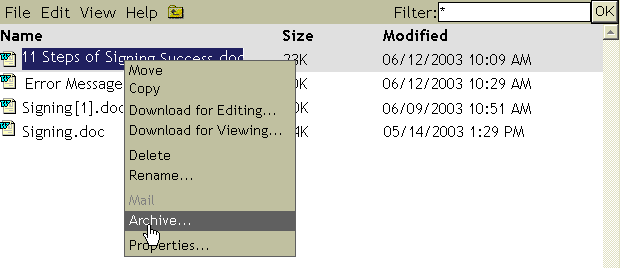
The user moves up a level in the NetStorage browser to select the guest directory, then clicks . A sample Directory Contents dialog box, shown in the following figure, lists the contents of the uservol:\data\guest directory.
Figure 5-2 Sample Archive Directory Contents Dialog Box
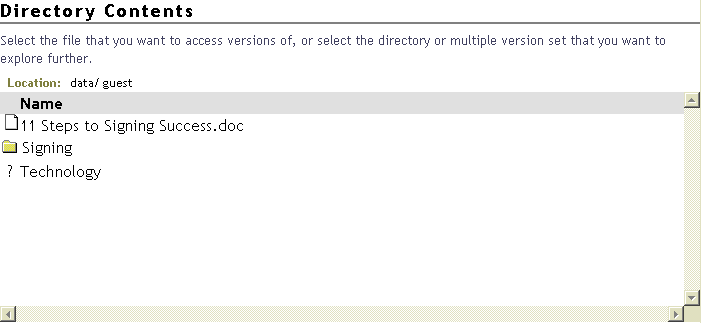
In this second search effort, the user decides to follow the path in the Technology subdirectory. As indicated by the question-mark icon, the Technology directory has multiple version sets available. To see the sample results of clicking on Technology, see Figure 5-4.
After selecting a directory-based version set in the Multiple Version Sets dialog, another Directory Contents dialog box appears to let the user choose a file version set in that subdirectory, as shown in the following figure.
Figure 5-3 Sample Archive Directory Contents Dialog Box for a Subdirectory
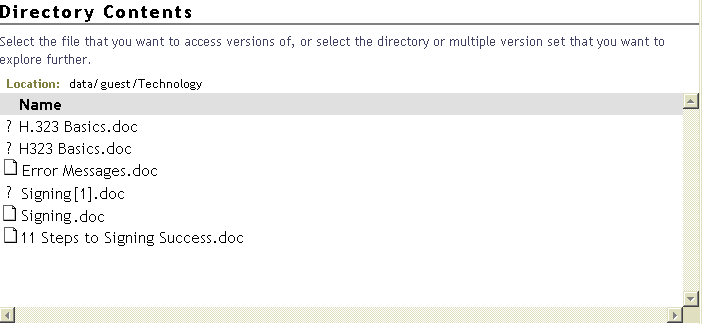
Then, the user clicks the file version set for the “11 Steps to Signing Success.doc” file. See Figure 5-5 for the results of this search.
5.2.2 Multiple Version Sets Dialog Box
The Multiple Version Sets dialog box lists the multiple instances of versions for the selected file or directory. Only files or directories to which you have rights appear in the list.
There are several reasons that multiple version sets can exist for a given file or directory:
-
You previously had a file with the specified filename, then renamed it. Later, you created a new file with the same filename.
-
You deleted a file. Later, you named a new file using the same filename.
-
You renamed a file to a new name, then renamed the file using the same characters as in the first filename, but modified the case. The archive database considers these three instances to be the same source file, but tracks its file version under the three filenames. For a renamed source file, the archive database presents its file versions as separate version sets with different filenames.
For example, suppose you renamed fileA as fileB, then renamed fileB as filea. Under each filename, versions were saved to the archive. When you retrieve previous versions of filea, the archive presents you with multiple version sets named as filea, fileB, and fileA. You choose the set that contains the file version you want to restore.
The list can contain multiple version sets for files (page icon) and for directories (folder icon). Each entry consists of the following information:
-
Location: The directory path. For example, data/userid/home.
-
Name: The full name of the directory or file, including its extension. For example, myfile.txt.
-
Status: The state of the versioned files (or directories) available by this name.
-
Current: The source file or directory currently exists.
-
Renamed: The source file or directory existed previously but is now named something else.
-
Deleted: The source file or directory existed previously but was deleted.
-
-
Modified: The last time that this file was versioned or that files in this directory were versioned.
-
Modifier: The userid of the individual who last modified the file or directory.
An Example Search of Multiple Directory Versions in the Archive Database
Continuing the example in Directory Contents Dialog Box, the user selected the Technology directory (see Figure 5-2). The Multiple Version Sets dialog box, as shown in the following figure, reveals that the user used the same directory name multiple times in the recent past. The user deleted a directory, then later created a new directory with the same name. Multiple version sets remain in the archive database for each of the previous versions of the directory. The user chooses the version of the directory based on the last date the directory was modified.
Figure 5-4 Sample Multiple Version Sets Dialog Box
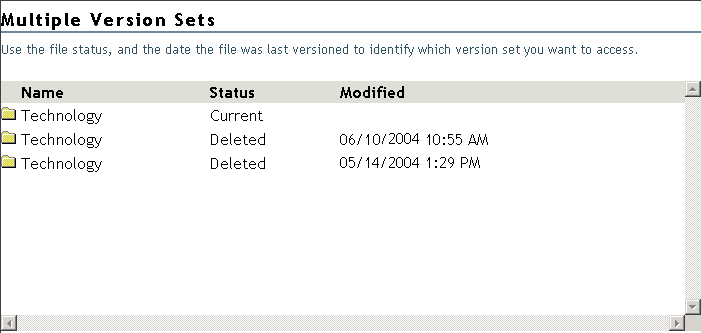
5.2.3 File Versions Dialog Box
The File Versions dialog box lists previous versions of the selected file that exist in the archive database. If you do not have rights to the file or to its versions, no entries appear.
The File Versions dialog box, such as the example shown below, provides the following information:
-
Location: The directory path.
-
Name: The full name of the file, including its extension. For example, myfile.txt.
-
Size: The file size in kilobytes (KB).
-
Archived: The time stamp when the file version was made.
You can perform one or more of the following tasks on a selected file version.
-
Restore To: Contains the path and filename where the restored file version will reside. Type the path and filename you want to use, or click the icon to browse to a location, then type the new filename. Click to restore the file.
-
Restore: Click to automatically download and save the selected file version to the path shown in the field. For security reasons, the file assigned their most recent settings for file system attributes, trustees, and trustee rights.
WARNING:Any file in the path with the same name as the file version will be overwritten. This destroys the contents of the current network file.
-
Download: Opens a Download dialog box. Browse to the location where you want to save a copy of the file version, rename the file (if desired), then click .
Click to back out of the download process.
The downloaded file inherits all the permissions and rights that you normally would have for any new file that you create on the network.
-
View: Downloads the file to your local temporary directory, then opens the file with the appropriate application so that you can view the contents.
IMPORTANT:You must have the application installed on your workstation in order to open the file to view it.
-
Close: Closes the dialog box.
An Example Search of File Version Sets in the Archive Database
Continuing the example in Directory Contents Dialog Box, the user selected the “11 Steps to Signing Success.doc” file version in the Technology folder. See the following figure to view the results of that search.
Figure 5-5 Sample File Versions Dialog Box
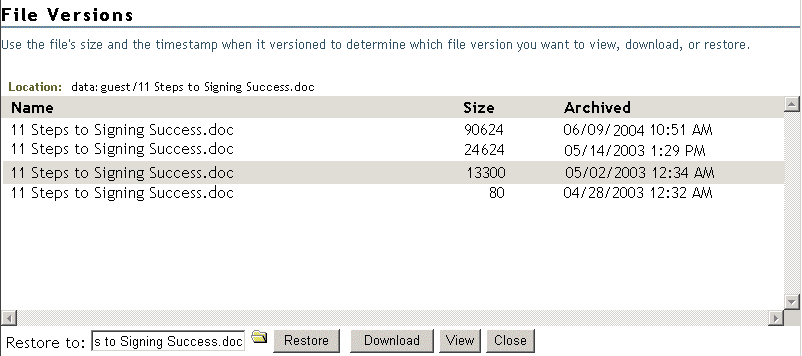
The user clicks the icon to search for the location where the file is to be restored, as shown in the following figure.
Figure 5-6 Sample of Using the Browser Search to Complete the Restore To Field
